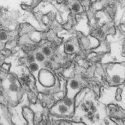UW-Madison prepares for new semester with flu in mind
As University of Wisconsin–Madison students, faculty and staff prepare for next week’s start of the 2009-10 academic year, administrators and campus health officials are finalizing plans to manage an expected re-emergence of the H1N1 influenza virus, or “swine flu.”
Flu activity is currently low in the United States, but based on the pattern of disease during the spring or summer, the U.S. Centers for Disease Control and Prevention (CDC) projects that the number of people who contract the disease could increase beginning this fall. College campuses are areas of special concern, as this strain of influenza has proven to be highly infectious in young adults.
Because new strains of influenza emerge from time to time, potentially causing disruptive outbreaks, a UW–Madison committee has been at work for the past several years, creating and refining plans for dealing with such a possibility.
The Campus Health Issues Planning (CHIPs) group, chaired by University Health Services (UHS) executive director Sarah Van Orman, M.D., has coordinated planning that has touched nearly every corner of campus, ranging from how to maintain critical research projects to how classes might be held via distance-learning technology in certain situations.
Participants have included representatives from UHS, University Housing, the Office of the Provost, the Office of Human Resources, the Division of Enrollment Management, University Communications and the University Police Department, among numerous other campus partners.
“As a community, we must do everything in our power to protect the health and well-being of our students, faculty, staff and visitors while we maintain our campus missions of teaching, learning and research by limiting the spread of disease,” wrote Chancellor Biddy Martin in an e-mail message to all students, faculty and staff today (Aug. 27).
When H1N1 first emerged in the U.S. in late spring, there was little disruption to normal campus operations. Given the CDC’s projections about a potential fall outbreak, the university has prepared for the possibility that influenza may spread widely enough to disrupt business as usual. Though it may seem like overpreparation to some, Van Orman notes that outbreaks of this nature are notoriously difficult to predict.
“I’m asking that we come to campus with a spirit of community, willing to use basic health measures to limit the potential spread of flu,” she says. “It’s also critical for everyone to learn about influenza and how our roles and campus could be impacted.”
Although the vast majority of people have made a full recovery from the H1N1 virus without medical treatment, even a mild case of influenza is an undesirable experience. Symptoms typically include the sudden onset of fever, cough, sore throat, headache, extreme fatigue and body aches.
In a minority of cases, particularly when people have certain pre-existing medical conditions, complications may result. Both globally and in Wisconsin, H1N1 has caused hospitalization and deaths.
As a result, Van Orman says she is asking members of the campus community to do several things:
- Wash hands frequently and thoroughly throughout the day; shield others by coughing or sneezing into sleeves or disposable tissues. Clean surfaces that are frequently touched.
- If you develop flu-like symptoms (fever with a cough and/or sore throat), follow CDC guidelines to stay home from work and class and limit contact with others until you are completely free of fever for at least 24 hours, without the use of fever-reducing medications. The CDC estimates this will take three to five days for most people.
In general, the university is recommending that students return home to recover with the assistance of their parents, guardians or family friends, whenever possible.
- Pay attention to information about flu. UW–Madison will post all updates to its flu Web site and use nearly all of its other communications tools to keep students, faculty, staff and parents up to date.
Seasonal influenza vaccine will become available by late September, and all members of the campus community are encouraged to be vaccinated. Plans are in place to provide H1N1 vaccine to target groups when it becomes available later this fall. The CDC has designated young adults under age 25 as a target group.
To coordinate information and operations, campus officials are working with the state of Wisconsin, the Department of Health Services, Dane County-Madison Public Health, UW System and other affiliates such as UW Hospital and Clinics and UW-Extension and Colleges.
One of the most difficult things for people to adjust to is the idea of staying home when ill, no matter what, according to Van Orman. The CDC reports that people shed the most influenza virus during the days they are feverish, which means that staying home is crucial to lowering the overall disease risk.
“I recognize that staying home when sick will require a shift in our campus culture, as most of us are accustomed to following through with our commitments even when ill,” Martin wrote in the e-mail message to campus. “I cannot stress enough that in this unusual semester, being a good citizen of this campus will actually mean staying home and not coming to work or class with a fever.”
For more information, visit UW-Madison’s flu site. After reviewing the information, anyone with questions is asked to e-mail pandemicinfo@uwpd.wisc.edu.



